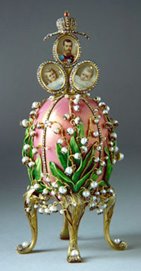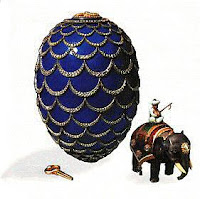 |
| Lillies of the Valley Egg |
Traditionally, eggs have symbolized birth and ultimate resurrection and were presented as gifts as early as the 16th century. But not until the late 1800's did such extravagant eggs as Faberge's appear with unsurpassed workmanship and value.
Peter Carl Faberge and his firm created the first imperial egg in 1885 for Czar Alexander III to present to his wife for Easter. Faberge himself did not work on the eggs but supervised Michael Perchin and Henrik Wigstrom in their creation.
Each original work of art was kept secret, even from the Czar, until the annual presentation to him at Easter.
Many of the eggs open to reveal a unique surprise: be it a bejeweled animal figurine, miniature portraits of the imperial family or musical birds. Lillies of the Valley Egg (1898), above, is a perfect example.
 |
| Pansy Egg |
The Pansy Egg (1899) opens to present a removable heart-shaped shield with eleven tiny doors that open to reveal miniature portraits - each monogrammed above in diamonds.
The amazing characteristic of these detailed eggs is not only their sparkling gems, but also their size; the Pansy Egg is only 5-3/4" high.
Contrasting works include the Pine Cone Egg (1900) and the Orange Tree Egg (1911).
The royal blue pine cone symbolizes resurrection and the ridges of the "cone" are delineated through draped lines of encrusted diamonds. Inside rests an impressive, miniature bejeweled elephant. The simple scheme of the royal blue and the sparkling diamonds on the egg itself is quite breathtaking.
 |
| Pine Cone Egg |
The detailed 11-3/4" tall Orange Tree Egg has individual leaves made of jade which, collectively, take the shape of an egg. It is the largest egg in the collection.
Precious stones add glistening color to give the image of a mixed fruit tree. When one particular orange gem is pushed, a tiny bird emerges from the top of the "tree" egg and sings, hence the name, the Orange Tree egg.
 |
| Orange Tree Egg |
There were fifty Imperial eggs made, and of those, only ten eggs are in the Kremlin. Eight are missing.
Photo credits in order of appearance: Lilies of the Valley Egg, pbs.org; Pansy Egg, homeclick.com; Pine Cone Egg, mieks.com; Orange Tree Egg, artukraine.com.

No comments:
Post a Comment